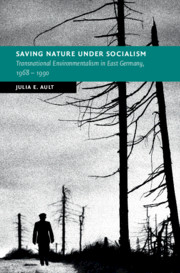Book contents
- Saving Nature Under Socialism
- New Studies in European History
- Saving Nature Under Socialism
- Copyright page
- Dedication
- Contents
- Figures
- Acknowledgments
- Abbreviations
- Introduction
- Chapter 1 Balancing Economy and Ecology: Building toward Environmental Protection, 1945–1970
- Chapter 2 “Socialist Environmentalism”: Between Ideal and Practice, 1971–1982
- Chapter 3 Church, Faith, and Nature: An Alternative Environmentalism, 1972–1983
- Chapter 4 Intertwining Environmentalisms: Transboundary Pollution and Protest in Central Europe
- Chapter 5 Coming Out From Behind the Cloud: Environmentalism after Chernobyl
- Chapter 6 Growing Together? The Environment in the Collapse of Communism
- Conclusion
- Bibliography
- Index
Chapter 2 - “Socialist Environmentalism”: Between Ideal and Practice, 1971–1982
Published online by Cambridge University Press: 30 August 2021
- Saving Nature Under Socialism
- New Studies in European History
- Saving Nature Under Socialism
- Copyright page
- Dedication
- Contents
- Figures
- Acknowledgments
- Abbreviations
- Introduction
- Chapter 1 Balancing Economy and Ecology: Building toward Environmental Protection, 1945–1970
- Chapter 2 “Socialist Environmentalism”: Between Ideal and Practice, 1971–1982
- Chapter 3 Church, Faith, and Nature: An Alternative Environmentalism, 1972–1983
- Chapter 4 Intertwining Environmentalisms: Transboundary Pollution and Protest in Central Europe
- Chapter 5 Coming Out From Behind the Cloud: Environmentalism after Chernobyl
- Chapter 6 Growing Together? The Environment in the Collapse of Communism
- Conclusion
- Bibliography
- Index
Summary
Chapter two traces the SED’s institutionalization of environmental protection and the party’s conviction that socialism provided solutions to pollution. The SED succeeded in creating a more environmentally minded population and, at least initially, tried to address concerns within existing structures. The SED used mass social campaigns to unite East Germans around the issue of environmentalism and practiced protection through policy and negotiating petitions. The GDR simultaneously reached out to other socialist countries to build coalitions around its brand of environmentalism in contrast to the one taking off in western Europe. This positioning intentionally placed the GDR in the middle of a regional and global phenomenon that spanned the Iron Curtain. Despite minor improvements, however, the discrepancy between rhetoric and lived reality produced a politically untenable situation. The SED relied on the Stasi to police the population, and ultimately opted to classify all environmental data in 1982.
Keywords
- Type
- Chapter
- Information
- Saving Nature Under SocialismTransnational Environmentalism in East Germany, 1968 – 1990, pp. 54 - 90Publisher: Cambridge University PressPrint publication year: 2021

